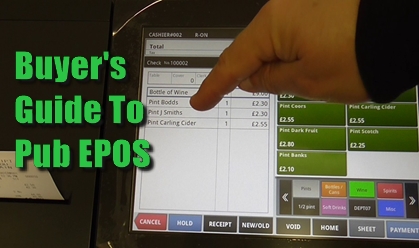You’ll find Electronic Point of Sale (EPOS) tills in the majority of major shop chains, restaurants and increasingly pubs and bars throughout the country. EPOS systems provide businesses that use them a convenient and speedy method of carrying out sales transactions with the added benefit of recording, analysing and reporting essential business information.
In the same way as old-fashioned tills record sales and issue receipts, EPOS retail systems also provide pubs a way of tracking stock, monitoring sales performance of individual stock lines and staff efficiency. Click on these links for more advice on Stock Take Reports and Stock Management.
How Do EPOS Systems Work?
An EPOS system is made up of a till, computer hardware and a software system (EPOS program) together with pieces of additional equipment (called peripherals) such as credit card readers and printers for your bar and your kitchen. They can be operated as stand-alone systems (there just to record sales etc) or as part of an integrated “back office” system (linking to your pub’s computer system, accounting and stock-taking software etc).
Whether they are traditional cash registers (with dedicated, pre-programmed buttons) or the touch screen variety, they provide any pub with an easy to use and accurate mechanism for dealing with customer sales orders and transactions.
Why Should I Use An EPOS System?
The software that operates a point of sales system will help your pub to accurately price your products, speed up customer service and reduce the possibility of human error or dishonesty by staff. For instance they can be easily and quickly programmed to allow for promotions or other special offers such as “meal deals” or “BOGOFFs” and then keep track of these discounted transactions for your accounts and your stock taker.
What Sort Of EPOS Equipment Will I Need?
An EPOS system will comprise of a computer and a visual display unit (VDU) such as a touchscreen monitor, for most pubs these items are integrated into one unit that also comprises a cash drawer and is placed on the front or back bar much the same way as a traditional cash register.
The other main peripherals you are likely to need, depending on your pub’s requirements are:
- a customer display (to show the customer how much their purchase totals
- a printer for customer receipts, copies of food orders or other voucher
- a credit/debit card reader for taking electronic payments
- a kitchen printer for food orders
- uninterruptible power supply (UPS) to keep your system running in the event of power loss
What Sort Of EPOS Software Will I Need?
The software is the “brains” of the system and those on offer today are very powerful but easy to use, your exact requirements will depend on your particular pub business and what sort of information you want the system to record, analyse and report.
Apart from the basic function of recording the sales in your pub an EPOS software system will provide additional functionality to help you run your business.
How Can EPOS Help Me Run My Pub?
Whilst EPOS is first and foremost a way of recording sales it can help with many other essential management tasks and free you up to do what you do best – interacting with your customers, managing your staff and maintaining service standards so that your customers keep coming back again and again.
A well designed EPOS system used by a well trained team will increase your pub’s productivity (customers get served quickly and efficiently), protect your stock and cash and increase your profitability.
An EPOS system will automatically take care of many of those time consuming back office functions mentioned above but will also allow you to venture into areas of promotion and marketing that big business use such as customer loyalty cards. If set up properly an EPOS system will manage not only your cash and stock but will help manage a customer database, including name and contact details and in some instances consumer purchasing patterns.
Continue reading … page 2
(Image courtesy of Cash Register Group)
